Eight of the world's most stunning floating homes
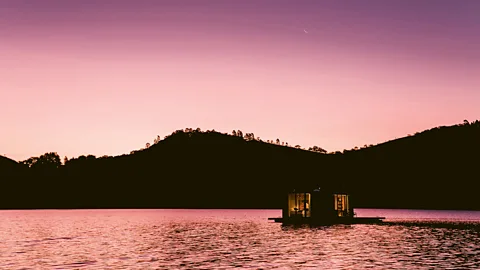 Mel Audi
Mel AudiFrom Scandinavia to the US, people are finding community and freedom living on water. Dominic Lutyens looks at eight examples of remarkable houseboats across the globe.
There is something rebellious and individualistic about swapping a life lived within bricks and mortar for a simpler, less conventional existence on a houseboat. Boat-dwellers feel a sense of adventure and, if based in a remote, rural spot, are totally at one with nature.
More like this:
The cover of a new book, Making Waves: Floating Homes and Life on the Water by Portland Mitchell, captures the freedom many associate with water-borne homes. Viewed through a porthole, two swans glide by on a glassy lake. In the foreground is a less distinct glimpse of a houseboat interior. Boat-dwelling isn't always plain sailing, however. After all, houseboats are often buffeted by the elements, while truly remote ones can be completely off-grid, which can take getting used to.
But houseboats are also often moored along with others in city wharfs, their occupants benefitting from a strong community spirit. In terms of design, houseboats vary stylistically and structurally, and many boat-dwellers take sustainable living and design seriously. "They're bringing everything from a rescued shipping container to a houseboat built from recycled materials on to the world's waterways," Mitchell tells BBC Culture.
Now with climate change precipitating rising sea levels, expediency is also driving a need for living on water. "Based on climate predictions, boat-dwelling might prove a prudent, even necessary alternative to land-based living, essential to human survival," adds Mitchell.
BBC Culture looks at eight examples of floating homes across the globe.
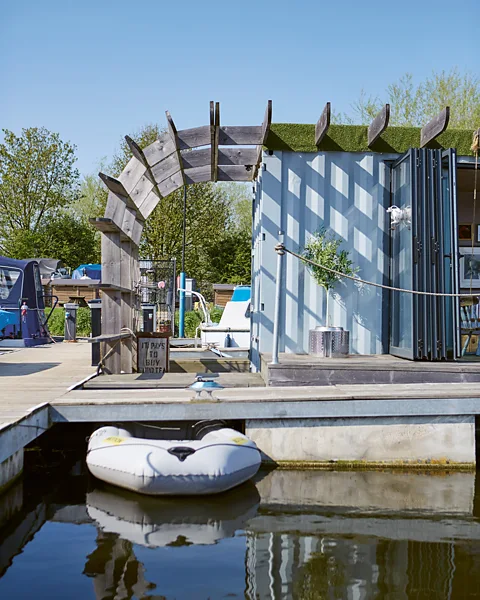 Brent Darby
Brent DarbyReetainer, UK
Max McMurdo's home is testament to the broad variety of houseboats that has emerged in the past decade. About seven years ago he converted a 12m by 2m metal shipping container that he'd bought for £2,000 ($2,500) at a London industrial estate, and created his new home, which now floats on the River Ouse in North Yorkshire.
This has allowed him to secure a mortgage-free home. He previously lived in a cottage in Bedford, which he renovated – upping its value – and then sold. Once the battered shipping container, which had travelled the world, had been reconditioned and transformed into his houseboat, McMurdo also fulfilled a long-held fantasy to live near or on water: "I'd always dreamt of living by the water in a tiny home," he says.
A former car designer, McMurdo had previously converted shipping containers into structures with different uses, including an office for his cottage's garden, and has a company that upcycles shipping containers, called Reetainer. His new home rests on a reinforced-concrete pontoon and a large deck that provides plenty of outdoor space. A wooden pergola crowns the roof, and projects beyond it to provide a more shaded area.
Clever space-saving ideas have allowed him to incorporate a normal domestic bathroom suite and shower. He also built a storage compartment on top of the floor of the shipping container, which contains a concealed bath, wardrobe, fridge and dining table that ascends through an opening in the living room floor via a scissor lift, and concertinas down when not in use. Pebble-covered mesh on the floor of the shower slides to reveal the bath, while his bed splits in the middle, revealing steps to the wardrobe.
Aiming to reduce his energy consumption, McMurdo has added solar panels, and plans to install energy-efficient infrared heating in the houseboat's ceiling.
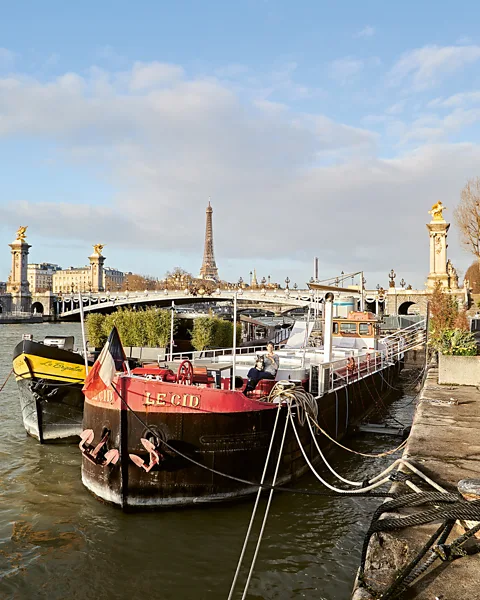 Tom Peppiat
Tom PeppiatLe Cid, France
In 2018, Agnès Combes Bernageau moved from her "cosy flat" in Paris to a transport barge moored on the Seine – between Pont Alexandre III and Pont de la Concorde – which she shares with her two children and French bulldog. It has a colourful history: it was built in 1930 in Mainz, Germany, then handed to France as part of the post-World War One reparations imposed by the 1919 Treaty of Versailles. During Hitler's occupation of France, it serviced German submarine flotillas, and in the 1950s was bought by British Petroleum.
Le Cid was moored in this Paris harbour in 1980. "I was bored of the impersonal life of conventional Paris," says Combes Bernageau, a senior executive at a French luxury brand, who bought the barge following "a gut feeling". The move has had positive psychological and physical effects on her: "I've gained a more open mind and heart – as well as a community with a common mindset of freedom. You learn a lot on boats – from mooring to all the technical stuff I knew nothing about. I gained muscle strength." There's a strong "community life", and a harbour committee that Combes Bernageau is part of.
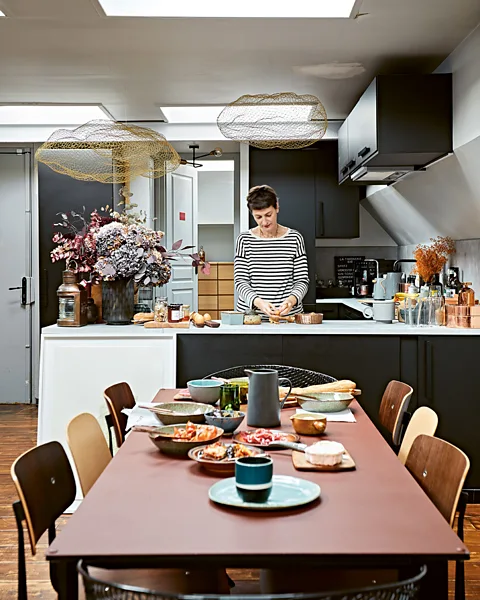 Tom Peppiat
Tom PeppiatCombes Bernageau has converted the interior of Le Cid into a stylish open-plan living room incorporating a well-equipped kitchen and dining area. There's also a crisply monochrome bathroom. The overall effect, below deck, is elegant, uncluttered and spacious.
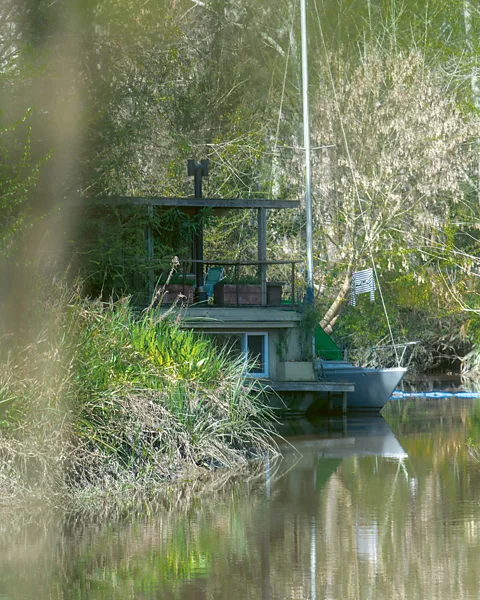 Daniel Fernandez Harper
Daniel Fernandez HarperMini, Argentina
Living on a houseboat can sometimes be sparked by an existential decision to abandon a humdrum life for one bringing greater self-determination. Anibal Guiser Gleyzer is a case in point. About 30 years ago, he found city-dwelling life unfulfilling. "So I bought a sailboat and explored the delta of the Paraná and Uruguay rivers," he says. He later sold his flat, acquired land in the delta and, aware that this wetland is prone to flooding, built a floating home.
Rather than conform to the European architectural style of many local buildings, he chose to create a self-build structure inspired by flat-hulled barges that traditionally transported wood through the delta. He wanted his design – a two-storey structure – to be made of environmentally friendly materials, and so fabricated the hull using ferro-cement, which involves applying reinforced mortar or plaster over an armature comprising metal mesh, expanded metal or metal fibres. The houseboat's walls are made of wood.
He has since established an eco community of similar, water-borne homes called Econáutico Hipocampo, whose occupants are equally drawn to living close to nature.
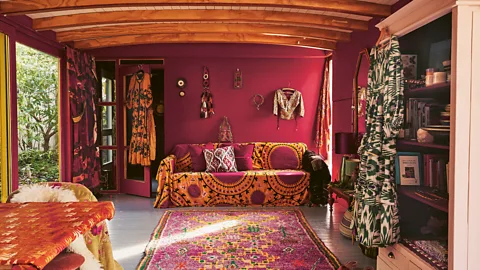 Muk Van Lil
Muk Van LilZazi Houseboat, Netherlands
For years Jeanne de Kroon, who has a vintage clothing business called Zazi Vintage, travelled the world, sourcing textiles and garments made by craftswomen. But she recently put down roots by renting a houseboat in a suburb of Amsterdam. "For travellers, a houseboat is the ultimate way to feel like you're on holiday at home," says the flamboyant de Kroon, who dresses in 1960s-style hippy outfits..
The wooden houseboat dates from the 1970s. De Kroon has added colour to its interior, painting walls rose-madder pink, and hanging dresses in her favourite shades of saffron yellow and crimson from door frames and furniture. "When you live on a boat on the Amsterdam canals, colour is important to warm up the space," she reasons.
De Kroon, who grew up in Amsterdam and New York, feels less isolated here than if she were living in an urban flat, she says: "I grew up in cities where you never meet your neighbours but boat life brings the community together – we exchange gifts and have a swimming club."
 Christina Kaiser/ Styling by Rikke Graff Juel
Christina Kaiser/ Styling by Rikke Graff JuelOldenburg, Denmark
When Lis and Ove Nilsson first saw their houseboat, Oldenburg, which dates from 1908, they were won over by its large size – ideal for hosting their family and friends. Admittedly, the wheelhouse, though fully operational, was poky, but the couple expanded it to create a spacious dining area. Their home also contains a kitchen, two bedrooms, a bathroom and walk-in wardrobe.
The boat's interior, with its white walls, pale floors and shipshape arrangement of furniture, is minimalist yet comfortable. There's a roomy sofa and upholstered seating in the dining area, while rooms are warmed up by traditional, varnished woodwork.
"We haven't missed anything by moving from land to water," they say. In fact, there was nothing unnatural about this: Lis spent childhood summers aboard a wooden fishing cutter. "We caught herring, plaice, sea trout and cod," she recalls. Since acquiring Oldenburg, the couple have gone on many sailing expeditions, mainly along the west coast of Jutland.
 Shivaun deLisser
Shivaun deLisserSoggybottom Shanty, US
A formative experience for Siva Aiken, owner of a houseboat eccentrically named Soggybottom Shanty, was her fixation with the Pirates of the Caribbean-themed ride at Disneyland in Anaheim, which her family frequented during her childhood. "There was an automaton man smoking a pipe and rocking in a chair on the front porch of a swamp cabin," she recalls. "I felt a pull to jump off the ride and move into that little shack."
She later moved to the South and became intrigued by the “rich history in America of the river people”. As conduits for transporting logs and coal, rivers there at the turn of the 20th Century became undesirable and polluted, populated by an impoverished community. "They built huts and flat-bottom shantyboats from offcuts of lumber," says the dog-loving Aiken who shares the vessel with several Bracco Italiano dogs.
Her 7m-long houseboat was made using recycled and discarded materials, with help from friends, in 2019. Its windows were salvaged from a home that was being fitted with new windows, while its second-hand outboard motor is 30 years old.
Aiken moors the boat by tying it to a jetty. She boards and disembarks from it using a sloping gang plank and, of an evening, relaxes playing the banjo on the porch of her home in an echo of the Pirates of the Caribbean ride that captivated her as a child.
 Mel Audi
Mel AudiAltar, Brazil
For Rodrigo Martins, his family and two friends, their compact but spacious eco, off-grid houseboat – moored to a buoy on the Jaguariuna reservoir two hours north of São Paolo – is a dream bolthole. This boxy, minimalist 38m-sq structure made of 100% recyclable materials is a prefab housing system called LilliHaus, manufactured by Brazilian sustainable design studio sysHaus. It sits on a wide, wraparound deck – supported by a catamaran – which adds 26m-sq more space. There are deckchairs on it, where after sunset the gang can watch movies projected on to an external wall that doubles as a cinema screen.
Used for weekend stays and holidays, and reached by a dinghy, the houseboat looks deceptively small. Yet it contains an open-plan living space with a dining area and kitchen, a double bedroom and a well-equipped bathroom. A simple Scandi-chic interior, featuring blond wood walls and understated furniture, makes the space feel bigger. Enhancing this is an abundance of daylight that floods into the space via floor-to-ceiling windows and skylights.
LilliHaus's eco features include rooftop solar panels that generate its electricity and energy-efficient lighting, openings in the structure providing natural ventilation and state-of-the-art water-treatment systems.
Martins admits his family and friends initially experienced panicky withdrawal symptoms when deprived of wifi – but were soon happy socialising more, swimming and paddling around in canoes.
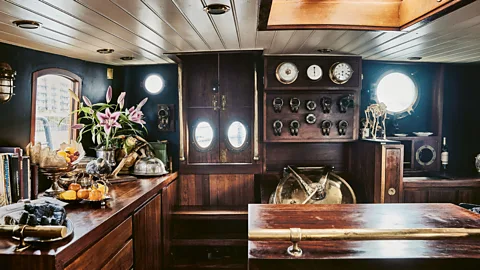 Roger Bool
Roger BoolDe Walvisch, UK
The interior of De Walvisch, a Dutch sailing clipper, now moored in Wapping, East London, is potently atmospheric. It boasts mahogany-toned wood walls and a plethora of striking objects with an old maritime provenance, all sourced by its occupants – artists Zatorski & Zatorski (a couple known as Thomas and Angel to their friends).
In 2000, the duo bought a narrowboat, which saw them develop a taste for living "slightly under the radar". Their decision to buy De Walvisch was reinforced by their interest in Wapping. "History is around every corner in this part of town," they say.
The couple restored the boat, kitting it out with reclaimed pieces, including a washbasin from a submarine. A porthole with a brass frame – rescued from SS Transylvania, the British passenger liner torpedoed and sunk by a German U-boat in 1917 – now graces the bow-windowed bedroom (formerly the captain's cabin).
The boat is berthed at Hermitage Moorings, a co-operative the artists helped to set up, which is shared with 17 other boats. This environment inspires the artists, who are interested in the potential of ships to symbolise discovery, new life and adventure. They document their life aboard the boat, and use it to stage artworks and performances, and to host salons, where people from different disciplines are invited to discuss their ideas.
Making Waves: Floating Homes and Life on the Water by Portland Mitchell is published by Thames & Hudson.
If you liked this story, sign up for the weekly bbc.com features newsletter, called The Essential List. A handpicked selection of stories from BBC Future, Culture, Worklife and Travel, delivered to your inbox every Friday.
If you would like to comment on this story or anything else you have seen on BBC Culture, head over to our Facebook page or message us on Twitter.
